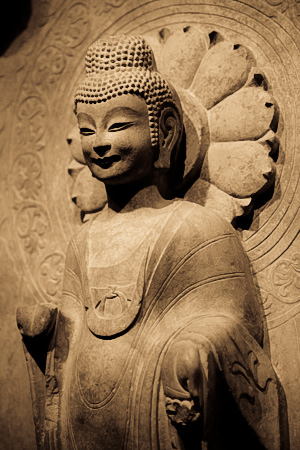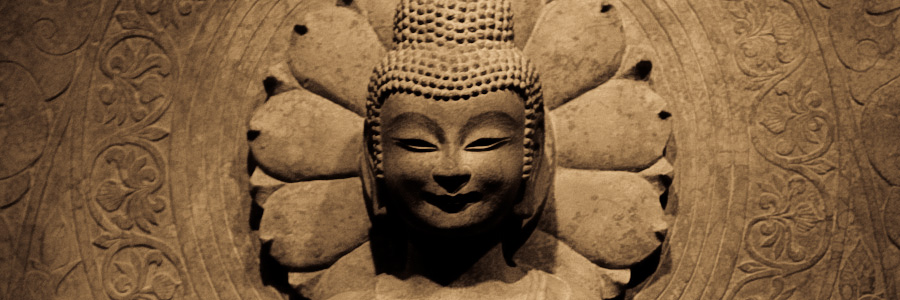Un’immagine vale più di mille parole. Le parole sono lente e un’immagine è immediata: in un momento di chiara percezione un’immagine può imprimere su di noi quello che solo ore di lettura sono in grado di trasmettere.
“Esistono divinità e altre creature mitologiche che possono essere lette come libri, non solo con la mente ma con le emozioni, a patto che siano sufficientemente sviluppate.” – George Gurdjieff
Gurdjieff sulle emozioni
La preparazione del centro emozionale

Il centro emozionale è il più veloce di tutti e quattro centri inferiori (vale a dire, il centro emozionale, motorio, istintivo e intellettuale). Le sue percezioni sono istantanee: quando entriamo in una stanza, immediatamente percepiamo se le persone presenti sono stanche, contente o polemiche. Avvertiamo se qualcuno è soddisfatto o scontento di noi, se si fida o diffida di noi, se ci vuole bene o ci teme.
Se la nostra velocità di percezione emozionale fosse indirizzata verso l’arte oggettiva, una scultura potrebbe immediatamente toccare una corda profonda del nostro essere.
Di solito però il centro emozionale è troppo denutrito perché lavori alla corretta velocità. La sua energia sottile viene persa attraverso le emozioni negative. È costretto a lavorare con un combustibile grezzo, come una vettura sportiva alimentata da un carburante non raffinato.
Per colmare il divario tra sonno e risveglio, il centro emozionale deve essere portato alla corretta velocità. Il lavoro della non espressione delle emozioni negative pone le basi per una corretta percezione emozionale. Prepara il cuore a ricevere una forma più alta di nutrimento, un combustibile più raffinato per renderlo più vicino ai centri superiori.
Il nutrimento derivato dall’arte oggettiva
L’arte oggettiva rappresenta tale nutrimento. Essa contiene il potenziale di trasformare lo spettatore. Trasmette volumi di saggezza, come Gurdjieff osservò nei suoi viaggi, ma questa saggezza non è verbale. Si tratta di una dose di energia senza parole, un respiro potente di nuova ispirazione.
La realtà è istantanea. Per penetrarla, non c’è tempo per le parole. Quindi il vantaggio di un’immagine su mille parole risiede nella velocità. Le parole comunicano con il centro intellettuale (il più lento di tutti i centri inferiori) mentre le immagini parlano con il centro emozionale (il più veloce di tutti i centri inferiori). L’arte oggettiva catapulta lo spettatore nel momento.
In altre parole, trasforma il centro emozionale in centri superiori, colmando il divario fra i mondi inferiori e superiori che coesistono nell’uomo.
“Durante i nostri viaggi nell’Asia centrale abbiamo trovato nel deserto ai piedi dell’Hindu Kush una strana figura che all’inizio credevamo fosse un’antica divinità o un diavolo. Di primo acchito ci è apparsa come una cosa curiosa. Ma dopo un po’ abbiamo iniziato ad accorgerci che questa figura conteneva molto altro: un grande sistema cosmologico completo e complesso.” Gurdjieff
Gurdjieff sull’arte intelligente

Il visitatore – spesso un pellegrino arrivato dopo un lungo viaggio – era accolto da una rappresentazione visuale di profonda serenità e consapevolezza. Se si fermava e lasciava che tale l’impressione penetrasse in lui (se era emozionalmente pronto) l’immagine poteva scioccarlo, riconducendolo alla realtà.
Guardate i Bodhisattva presenti in questo post. È evidente che raffigurano molti tratti dell’illuminazione – un libro non basterebbe per descriverli: la saggezza, la compassione, la consapevolezza, la contentezza, la concentrazione, la flessibilità e molti altri. Lo scultore ha espresso nella pietra ciò che gli autori del Dhammapada hanno trasmesso per iscritto ma, essendo visuale, il suo messaggio entra in un cuore ben preparato all’istante.
In ultima analisi, l’arte oggettiva si sforza di rappresentare l’uomo oggettivo. Riflette non solo ciò che è ma anche quello che potrebbe diventare.
© BePeriod
